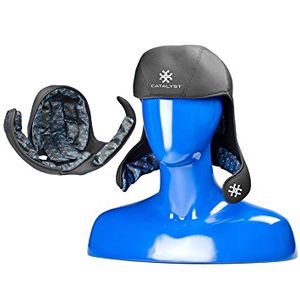Cryotherapy
Cryotherapy is the local or general use of low temperatures. Methods of lowering temperature include ice packs, ice bathing, and exposure to low environmental temperature. Some studies have shown that cold exposure can be anti-inflammatory,[1] immunomodulatory, and to extend life in model organisms.[2] This may be due to hormesis and the effects of heat shock proteins and cold shock proteins. However, as most research has been conducted in animals and in healthy human controls, there is limited evidence for cryotherapy in the treatment of chronic disease.
Methods[edit | edit source]

Methods of lowering temperature include ice packs, ice bathing, and exposure to low environmental temperature.
Health effects[edit | edit source]
Immune system[edit | edit source]
Cryotherapy may improve response to experimental endotoxin exposure. Hypothermic rabbits have a ten times greater resistance to bacterial endotoxins than normal rabbits.[3][4] One study in humans attempted to test the effects of Wim Hof's "method" – a combination of meditation, breathing techniques and immersion in cold water to activate the sympathetic nervous system – in a group of healthy volunteers. As compared to the control group, the treatment group had improved immune response when exposed to e-coli.[5]
Environment[edit | edit source]
Hypothermic rodents to have a greater resistance to irradiation.[6]
Longevity[edit | edit source]
Numerous studies of invertebrate model organisms such as Drosophilamelanogaster and C. elegans have shown colder temperatures increase lifespan.[7][8][9] Studies of fish and amphibians in both the wild and in laboratory settings have also shown a positive correlation between colder temperature and lifespan.[2]
In the rodent literature, there are several examples of cold increasing lifespan. Mice genetically engineered to have a reduced body temperature of 0.3 degrees to 0.5 degrees C had a greater median life span (12% increase in males; 20% increase in females) than normal mice.[10] Rats exposed to a cool water bath four hours a day lived 10% longer than controls, despite eating 44% more calories.[11] (Caloric restriction, which has been shown to increase lifespan in numerous studies of model organisms, may have its effects via the lowering of body temperature rather than the direct effects of reduced caloric intake. Some studies have shown the effects of caloric restriction may be attenuated in animals raised at higher room temperatures.[2])
Evidence[edit | edit source]
Concussion and migraine[edit | edit source]
A randomized controlled trial of an icepack applied to the carotid arteries of the neck found it significantly reduced pain when used at the onset of migraine.[12] In open label trial, a similar treatment improved the symptoms of migraine[13] and of post-traumatic headache.[14]
Chronic fatigue syndrome[edit | edit source]
There is no evidence for the use of cyrotherapy in Chronic Fatigue Syndrome. Dr. Charles Lapp and Dr. Paul Cheney have both used immersion in tepid water as a therapy for patients.[15]
Fibromyalgia[edit | edit source]
Cryotherapy has been advertised as effective for fibromyalgia, but in 2017, the UK's Advertising Standards Authority ruled that the company Chill WBC Limited did not have substantial or good quality evidence that it was effective for pain in fibromyalgia or other chronic conditions.[16]
See also[edit | edit source]
Learn more[edit | edit source]
References[edit | edit source]
- ↑ Shibata, R (2009). "Adiponectin and cardiovascular disease". Circ. J. 73 (4): 608–614. PMID 19261992.
- ↑ 2.0 2.1 2.2 Keil, Gerald (2015). "Being cool: how body temperature influences ageing and longevity". Biogerontology. 16 (4): 383–397.
- ↑ Liu, R.K. (1972). "The Effect of Lowered Body Temperature on Lifespan and Immune and Non-Immune Processes". Gertontology. 18: 363–388.
- ↑ Rikke, Brad (2004). "Lower body temperature as a potential mechanism of life extension in homeotherms". Experimental Gerontology. 39: 1431.
- ↑ Kox, Matthijs (2014). "Voluntary activation of the sympathetic nervous system and attenuation of the innate immune response in humans". Proceedings of the National academy of Sciences. 111 (20): 7379–7384.
- ↑ Storer, John (October 1952). "Hypothermia and increased survival rate of infant mice irradiated with X-rays". American Physiological Society. 171 (2): 341–348.
- ↑ Kelly, MA (September 2013). "Effect of temperature on the rate of ageing: an experimental study of the blowfly Calliphora stygia". PLoS One. 8 (9): e73781.
- ↑ Voorhies, Van (1999). "Genetic and environmental conditions that increase longevity in Caenorhabditis elegans decrease metabolic rate". Proceedings of the National Academy of Sciences. 96 (20): 11399–403.
- ↑ Miquel, J (September–October 1976). "Effects of temperature on the life span, vitality and fine structure of Drosophila melanogaster". Mech Ageing Dev. 5 (5): 347–70.
- ↑ Conti, B (November 2006). "Transgenic mice with a reduced core body temperature have an increased life span". Science. 314 (5800): 825–8.
- ↑ Holloszy, JO (November 1986). "Longevity of cold-exposed rats: a reevaluation of the "rate-of-living theory"". Journal of Applied Physiology. 61 (5): 1656–60.
- ↑ Sprouse-Blum, Adam (July 2013). "Randomized Controlled Trial: Targeted Neck Cooling in the Treatment of the Migraine Patient". Hawaii J Med Public Health. 72 (7): 237–241.
- ↑ Ulcer, Serap (December 2016). "Cold Therapy in Migraine Patients: Open-label, Non-controlled, Pilot Study". Evid Based Complement Alternat Med. 3 (4): 489–493.
- ↑ Jensen, OK (October 1990). "An Open Study Comparing Manual Therapy with the Use of Cold Packs in the Treatment of Post-Traumatic Headache". Cephalalgia.
- ↑ American Myalgic Encephalomyelitis and Chronic Fatigue Syndrome Society. "Hydrotherapy | Treatment Database". American Myalgic Encephalomyelitis and Chronic Fatigue Syndrome Society. Retrieved June 6, 2022.
- ↑ "ASA Ruling on Chill WBC Limited". Advertising Standards Authority. November 29, 2017. Retrieved June 6, 2022.

